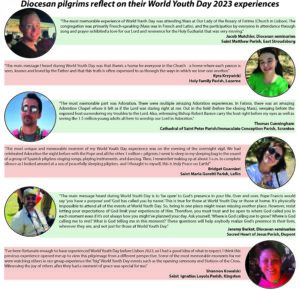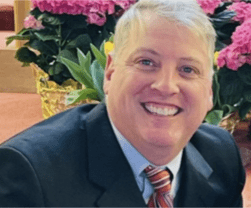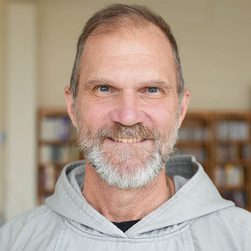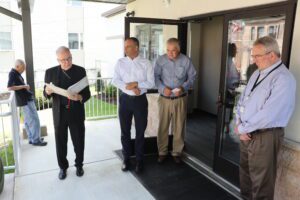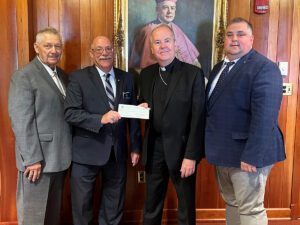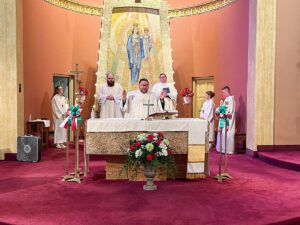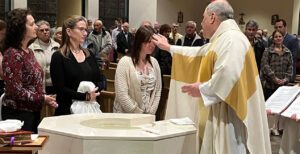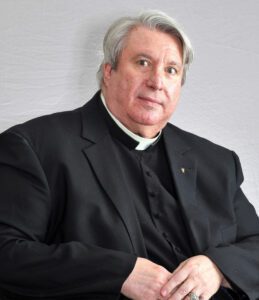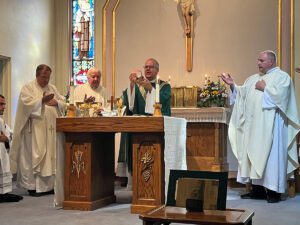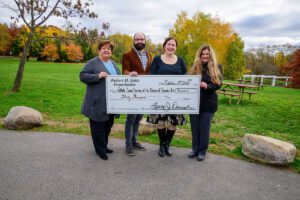LISBON, Portugal (CNS) – Pope Francis asked the 1.5 million young people who attended World Youth Day to take “what God has sown into your hearts” back to their home countries and build a joyful church that is open to all.
Young pilgrims, including the 21 from the Diocese of Scranton who made the trip to Portugal, constantly reflected on the pope’s main point during the official welcome ceremony for World Youth Day Aug. 3: in the church there is room for “everyone, everyone, everyone.”

He asked the jubilant crowd of flag-waving young people to repeat the refrain with him in Lisbon’s Eduardo VII Park and shouts of “todos, todos, todos” – “everyone” in Spanish and Portuguese – spread throughout the crowd.
As he did often during the trip, the pope solicited engagement from the crowd, asking them to repeat after him or consider in silence a question he posed.
Yet was during his meeting Aug. 2 with Portuguese bishops, priests, religious and pastoral workers that the pope first issued his “todos” message.
“Please, let us not convert the church into a customs office” where only the “just,” “good,” and “properly married” can enter while leaving everyone else outside, he said. “No. The church is not that,” he said, rather it is a place for “righteous and sinners, good and bad, everyone, everyone, everyone.”
Asked during his inflight news conference Aug. 6 how the church can be for everyone when women and gay people are excluded from some sacraments, Pope Francis said that “the church is open to all, but then there is legislation that regulates life inside the church.”
“This does not mean that (the church) is closed. Each person encounters God by their own way, inside the church, and the church is mother and guides each one by their own path,” he responded.
At 86 years old, Pope Francis showed no sign of slowing down for the 42nd international trip of his pontificate, which he jokingly told journalists on the flight to Lisbon will “make me young again.”
The pope’s packed agenda had three to four official events per day, and he added private meetings with several groups and individuals at the Vatican nunciature in Lisbon where he was staying. Among them was a group of abuse survivors who met with the pope for over an hour Aug. 2, during which they “dialogued about this plague” of abuse, the pope said.
The pope celebrated Mass with 1.5 million young people sprawled across Lisbon’s riverside Tejo Park Aug. 6 and told them not to be afraid of pursuing their great dreams to change the world.
“Let’s all repeat this phrase in our hearts: ‘Don’t be afraid,’” Pope Francis told the crowd. “Jesus knows the hearts of each one of you, the successes and the failures, he knows your hearts. And today he tells you, here in Lisbon for this World Youth Day: ‘Don’t be afraid.’”
In addition to listening the testimonies of young people and fielding questions from some of them during public events, Pope Francis had a chance for more direct interactions with several young people during the trip. He heard the confessions of three pilgrims and ate lunch with a group of 10 young people Aug. 4.
The pope later shared that he spoke to one young man who had previously considered taking his own life and said youth suicide is a problem today, noting the challenge is especially prevalent in places where universities and the job market are very demanding.
After the closing Mass, the pope announced that Seoul, South Korea, would be the location for the next World Youth Day in 2027, drawing great applause from the South Korean delegations scattered throughout the crowd.
The previous morning, Pope Francis visited the Shrine of Our Lady of Fátima, where he again put aside his prepared remarks and spoke off the cuff, focusing on Mary and skipping over an expected prayer for peace in the world.
He later said that “I prayed to Our Lady, and I prayed for peace” before a statue of Our Lady of Fátima, but “I did not advertise.”
In the shrine’s Chapel of the Apparitions, marking the exact spot where the three Portuguese children claimed to see Mary in 1917, he said the open-air chapel “is like a beautiful image of the church, welcoming, without doors, so that all can enter.”
During the Aug. 6 press conference, Pope Francis also brushed off concerns about eyesight issues that arose after he joked that his glasses “aren’t working” at one of his events and continued to largely improvise his remarks for the rest of his trip. And he said his health and recovery from abdominal surgery in June is “going well.”

